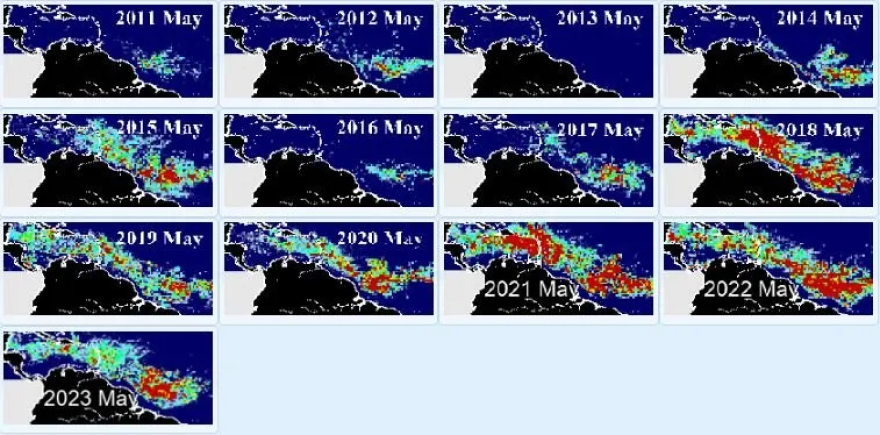The ominous mass of seaweed looming in the Atlantic and creeping our way set size records earlier this spring — it was huge. But last month it actually shrank, according to scientists from the University of South Florida.
The belt is supposed to get bigger at this time of year. In fact, this is the first time since studies began in 2011 that the amount of sargassum in the Atlantic in May has decreased. All told, the May seaweed totals were about 15% smaller than those in April, with most of the reduction happening in the eastern Atlantic.
Also of note, the May 2023 amounts of seaweed are less dense than those of the past two years. “Sargassum amount in the Gulf of Mexico is likely to decrease in June, which is good news for many coastal residents of Florida,” stated USF’s Optical Oceanography Laboratory website.
The seaweed has been washing up on Florida’s east coast beaches for months now, and many feared a summer of stinky beaches. When the seaweed sits in the sun and decomposes, it releases hydrogen sulfide, which can smell like rotten eggs and cause respiratory problems.
The USF scientists measure the sargassum belt by combining satellite imagery from NASA and the U.S. Geological Survey. The imagery reveals where the seaweed is, and how densely it’s growing.
The seaweed decrease is a bit of a mystery. A USF release said that from March to April, the sargassum quantity in the eastern Atlantic was cut in half, and then cut in half again in May. That means less seaweed on the currents that sweep the stuff east into the Gulf of Mexico, and eventually to us.
Despite the good news, there has still been a profound increase in sargassum in the Atlantic, and thus Florida’s beaches, compared to the early years of the study, which began in 2011.

Why the overall increase? Brian Lapointe, a research professor with Florida Atlantic University, suspects that it may be because the area where sargassum grows has shifted south away from the Sargasso Sea, a massive area off the U.S. southern seaboard, and toward the equator.
“We never historically had sargassum growing in that [southern] area until 2011,” said Lapointe. “Once it got there, it liked it — there were nutrients to support its growth.”
Lapointe said that as the seaweed then travels west, it encounters a nutrient-rich plume of ocean water emanating from the Amazon River. The nutrients fuel the microalgae’s growth. Starting in 2014, there was a large uptick in nitrogen and phosphate coming out of the Amazon, he said. Other nutrient sources include the Congo River and the Mississippi River.
The highest density of seaweed right now is still off the coast of South America, so it will be making its way to Florida over the summer.
The release said that “although the quantity will still remain to be relatively high as compared to historical values” the Gulf of Mexico will likely see a decrease of sargassum in June, “which should be good news to the residents along the Florida Keys and east coast of Florida.”
This story was produced in partnership with the Florida Climate Reporting Network, a multi-newsroom initiative founded by the Miami Herald, the South Florida Sun Sentinel, The Palm Beach Post, the Orlando Sentinel, WLRN Public Media and the Tampa Bay Times.
Copyright 2023 WLRN 91.3 FM. To see more, visit WLRN 91.3 FM. 9(MDA4MzM1MjM1MDEzMTg5NTk0MzNmOTQ5MA004))

